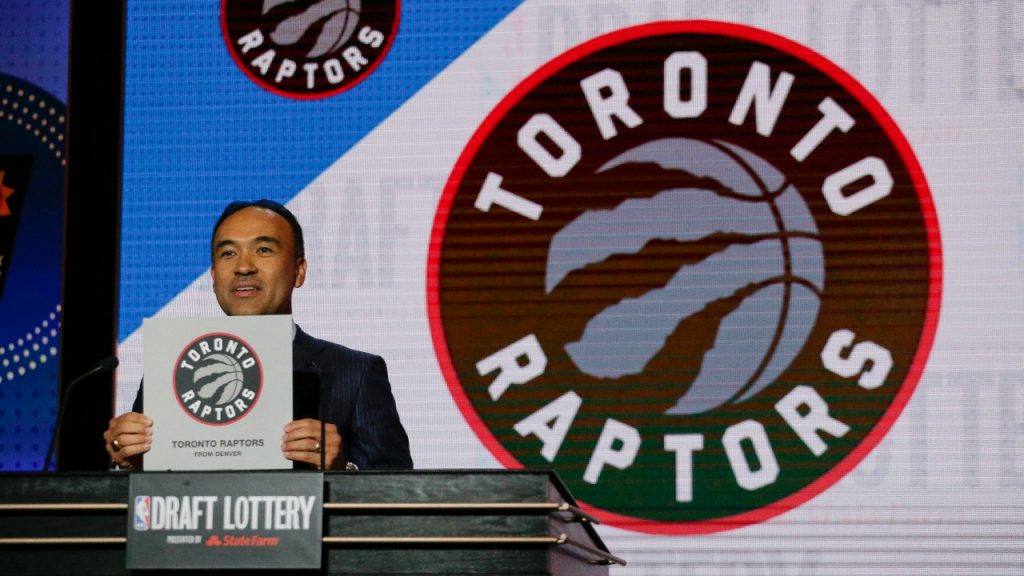The draft lottery wasn’t kind to the Toronto Raptors, and Aaron Rose explains what it all means.

After tanking the final month of the basketball season to improve their odds, they slipped two spots and landed at No. 9. It wasn’t a dramatic fall, but it dashed hopes of jumping into the top four and landing a true franchise-changer. Cooper Flagg is the clear No. 1, and while a couple of others have separated near the top, the rest of the class remains wide open in the middle of the lottery.
Toronto enters the draft with a clear need for a young center and a crowded backcourt short on real difference-makers. Still, history suggests they will stick to their philosophy: take the best player available and worry about fit later. This is a front office that tends to surprise people. Whether it is betting on upside, size, or long-term development, the Raptors rarely follow consensus and they will have intriguing options again at No. 9.
The Consensus Pick: Khaman Maluach | C | Duke
A consensus seems to have formed around Duke freshman Khaman Maluach being Toronto’s pick at No. 9, and it’s not hard to see why. He fills a positional need, brings long-term upside, and fits the kind of size-plus-tools profile the Raptors tend to prioritize. At 7-foot-2 with fluid movement, Maluach already shows strong timing as a shot blocker and can survive in space better than most bigs his size.
He averaged 8.6 points, 6.6 rebounds, and 1.3 blocks per game while shooting 71.2% from the field and 76.6% from the line. At the combine, he hit 22-of-48 from three in shooting drills and 9-of-10 free throws, enough to buy into the idea of long-term shooting growth. He is not a polished passer or scorer yet, and he’ll need to fill out his frame to handle NBA physicality, but that is fine for Toronto.
With Jakob Poeltl in place, the Raptors can afford to slow play Maluach’s development. The tools are real, the defensive ceiling is high, and the offensive flashes suggest he won’t be a non-factor on that end. If the shot comes around, he becomes a modern two-way big who can anchor a playoff defense without hurting your spacing.
The Anunoby Replacement: Carter Bryant | F | Arizona
The Raptors haven’t really found a true OG Anunoby replacement since trading him to the New York Knicks last season. Ochai Agbaji showed flashes this year, but he is still more of a rotation piece than a defensive stopper or floor-spacer in a starting unit. At No. 9, there are no perfect prospects, and Carter Bryant is far from polished. But the role he projects to fill is one that fits just about every NBA team.
Bryant is a 6-foot-8 wing with a 6-foot-11 wingspan, a 39.5-inch vertical, and clear two-way traits. He averaged just 6.5 points per game at Arizona, but the low usage hides some encouraging signs. He shot 37.1% from three, showed smart cutting instincts, and posted excellent defensive playmaking rates.
He’s not a creator and likely never will be, but he doesn’t need to be. Bryant’s value comes from being able to switch defensively, hit open shots, and slide into lineups without disrupting flow. If the jumper holds and the frame fills out, he could be the kind of low-maintenance, high-impact wing that Toronto has missed since Anunoby left.
The question is whether the limited production is a warning sign or just a reflection of a muted role in college. Toronto has never shied away from betting on tools and projecting forward. Bryant fits that mold.
More Guard Help: Kasparas Jakucionis | G | Illinois
Toronto already has a crowded backcourt, but Kasparas Jakucionis brings something the Raptors still need. He is among the best half-court creators outside the top of the draft and would immediately be one of the team’s most polished offensive guards. At 6-foot-5 with good size and feel, he offers an appealing mix of shot creation, live-dribble passing, and control of tempo.
He averaged 15 points, 4.7 assists, and 5.7 rebounds per game for Illinois while shooting 84.5% from the free throw line. At the combine, he continued to impress, hitting 17-of-25 in the 3-point drill, 14-of-25 on movement threes, and 8-of-10 from the line. His shot is trending up, and he already plays with a level of poise and efficiency that translates well to playoff basketball.
Jakucionis is not a high-end athlete and may need help guarding quicker guards, but his ability to operate in the half court and scale next to other creators makes him an intriguing long-term fit. For a team still searching for offensive structure, he gives Toronto another real option.
Big Man With Questions: Derik Queen | C | Maryland
Derik Queen is one of the most polished offensive bigs in the class. He averaged 16.5 points, 9 rebounds, and 1.9 assists per game at Maryland, shooting 52.6% from the field and 76.6% from the line. He brings a rare blend of post scoring, footwork, and passing vision, creating offense from the block, elbow, or short roll with a level of craft that few bigs his age possess.
The challenge is figuring out where he fits. At 6-foot-9, he’s undersized for a true center, but not quite the ideal modern four either. He’s not a floor spacer yet, shooting just 20% from three, and his rim protection numbers are modest. While he moves better than expected in space, he doesn’t profile as a defensive anchor or switch-everything big. Queen’s scoring touch and playmaking give him a high offensive floor, but the fit is unconventional. He’s more of an old-school power forward in a league that increasingly favours stretch and rim-running bigs.